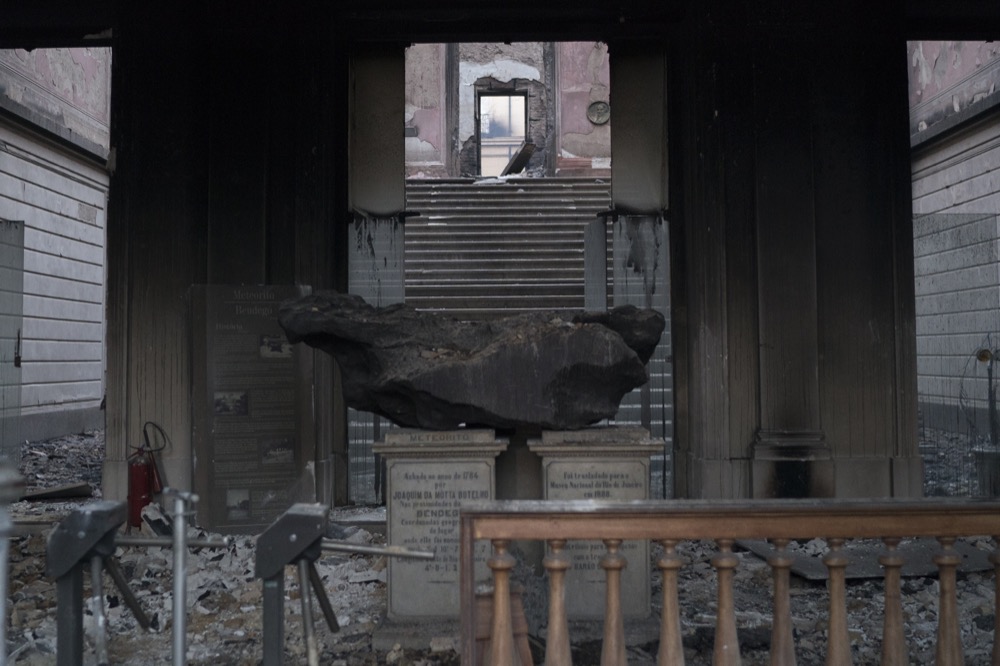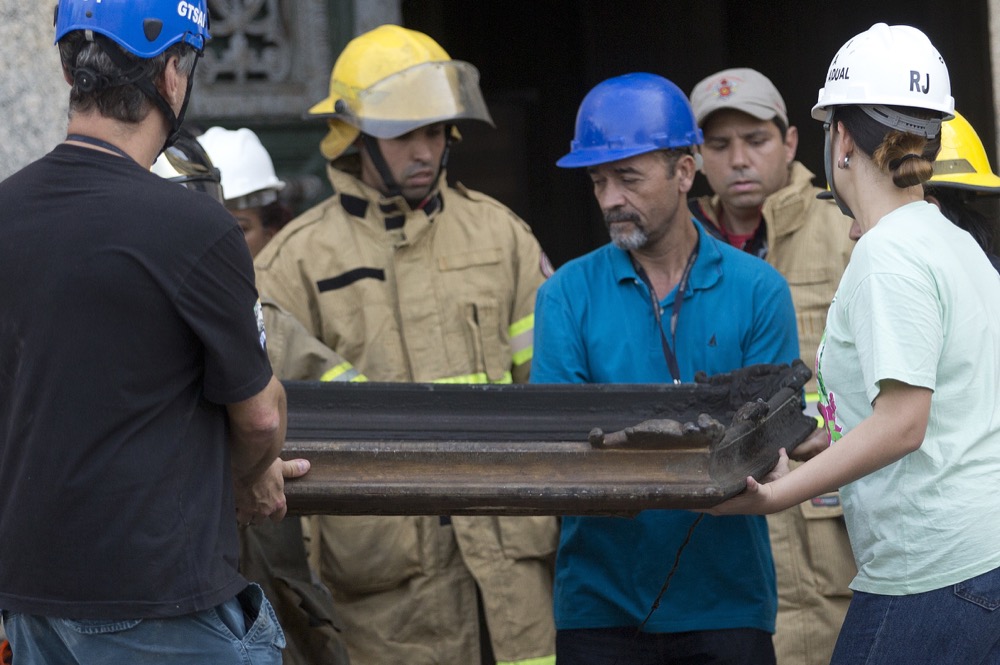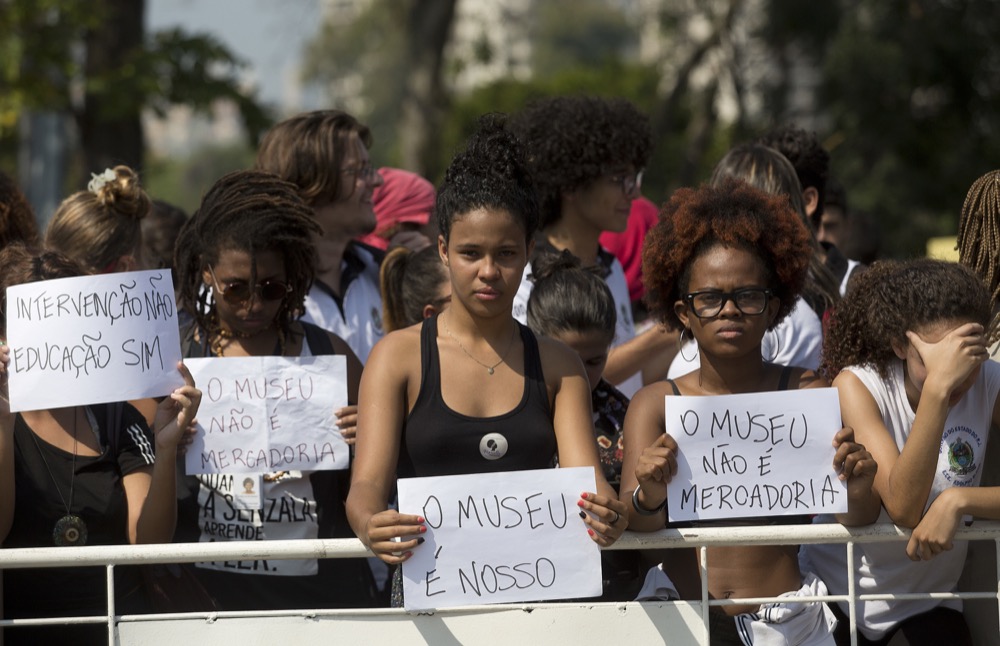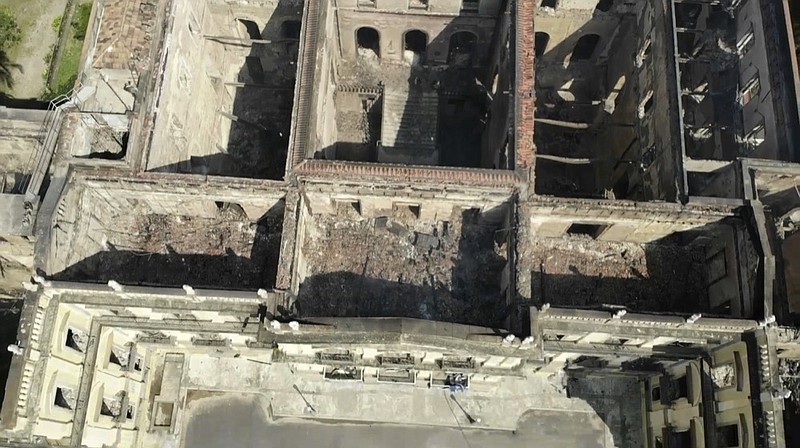 Students and National Museum employees protest outside the institution after it was gutted by an overnight fire in Rio de Janeiro, Brazil, Monday, Sept. 3, 2018. Recriminations flew over who was responsible for the loss of at least part of Latin America's largest archive of historical artifacts, objects and documents. (AP Photo/Silvia Izquierdo)
Students and National Museum employees protest outside the institution after it was gutted by an overnight fire in Rio de Janeiro, Brazil, Monday, Sept. 3, 2018. Recriminations flew over who was responsible for the loss of at least part of Latin America's largest archive of historical artifacts, objects and documents. (AP Photo/Silvia Izquierdo)
RIO DE JANEIRO (AP) - Forensic investigators and researchers awaited access Tuesday to the National Museum of Rio de Janeiro, gutted in a fire, to find out how the blaze began and what remains of the 20 million artifacts that made the museum one of the most important in Latin America.
After a fire tore through the museum Sunday, engineers were doing tests on the structure to make sure it wouldn't collapse. Authorities had expressed concern Monday that internal walls and parts of the roof were weak.
 A meteorite on exhibit is seen inside the entrance of the National Museum after an overnight fire in Rio de Janeiro, Brazil, Monday, Sept. 3, 2018. Firefighters dug through the burned-out hulk of Brazil's National Museum on Monday, a day after fire gutted the building, as the country mourned the irreplaceable treasures lost and pointed fingers over who was to blame. (AP Photo/Leo Correa)
A meteorite on exhibit is seen inside the entrance of the National Museum after an overnight fire in Rio de Janeiro, Brazil, Monday, Sept. 3, 2018. Firefighters dug through the burned-out hulk of Brazil's National Museum on Monday, a day after fire gutted the building, as the country mourned the irreplaceable treasures lost and pointed fingers over who was to blame. (AP Photo/Leo Correa)
The museum held Latin America's largest collection of historical and scientific artifacts, and officials suggested that the damage could be catastrophic, with one official telling a Brazilian news outlet that as much as 90 percent may have been destroyed.
The cause of the fire was not known. Federal police will investigate since the museum was part of the Federal University of Rio de Janeiro. But protesters, commentators and museum directors themselves said years of government neglect had left the museum so underfunded that its staff had turn to crowdfunding sites to open exhibitions. In another example of struggling public services, firefighters initially struggled to contain it because the hydrants closest to the museum did not work. Instead, trucks had to gather water from a nearby lake.
 Firefighters and museum personnel carry away a burnt painting from the National Museum after an overnight fire in Rio de Janeiro, Brazil, Monday, Sept. 3, 2018. A huge fire engulfed Brazil's 200-year-old museum, lighting up the night sky with towering flames as firefighters and museum workers raced to save historical relics from the blaze. (AP Photo/Silvia Izquierdo)
Firefighters and museum personnel carry away a burnt painting from the National Museum after an overnight fire in Rio de Janeiro, Brazil, Monday, Sept. 3, 2018. A huge fire engulfed Brazil's 200-year-old museum, lighting up the night sky with towering flames as firefighters and museum workers raced to save historical relics from the blaze. (AP Photo/Silvia Izquierdo)
Roberto Leher, rector of the Federal University of Rio de Janeiro, said it was well known that the building was vulnerable to fire and in need of extensive repairs. In fact, the institution had recently secured approval for nearly $5 million for a planned renovation, including an upgrade of the fire-prevention system, but the money had not yet been disbursed.
On Monday, officials promised $2.4 million to shore up the building and promised to rebuild the museum.
"Those saying that the museum will be rebuilt are not telling the truth," said Luiz Philippe de Orleans e Braganca, an heir to Brazil's last emperor. "The building could be rebuilt, but the collection will never again be rebuilt. Two hundred years, workers, researchers, professors that dedicated in body and soul (to the museum) ... the work of their life burned due to the negligence of the Brazilian state."
 Students and National Museum personnel protest outside the museum which suffered an overnight fire in Rio de Janeiro, Brazil, Monday, Sept. 3, 2018. The signs in Portuguese read: "The museum is ours," and "The museum is not merchandise." Recriminations flew over who was responsible for a huge fire that destroyed of at least part of Latin America's largest collection of historical artifacts and documents. (AP Photo/Silvia Izquierdo)
Students and National Museum personnel protest outside the museum which suffered an overnight fire in Rio de Janeiro, Brazil, Monday, Sept. 3, 2018. The signs in Portuguese read: "The museum is ours," and "The museum is not merchandise." Recriminations flew over who was responsible for a huge fire that destroyed of at least part of Latin America's largest collection of historical artifacts and documents. (AP Photo/Silvia Izquierdo)
The museum, whose main building was once home to the royal family, had extensive paleontological, anthropological and biological specimens. It also contained a skull called Luzia that was among the oldest fossils ever found in the Americas. It held an Egyptian mummy and the largest meteorite ever discovered in Brazil - one of the few objects that officials could confirm had survived. Some parts of the collection were held at others sites and thus spared.
Luiz Fernando Dias Duarte, the museum's deputy director, said that anything held in the main building was likely destroyed, and Cristiana Serejo, a vice-director of the museum, told the G1 news portal that maybe around 10 percent of the collection had survived.
For many in Brazil, the state of the 200-year-old natural history museum quickly became a metaphor for what they see as the gutting of Brazilian culture and life during years of corruption, economic collapse and poor governance.
Brazil has struggled to emerge from a two-year recession and seen its political and corporate elite jailed in Latin America's largest corruption investigation. The country has been riven with deep political divisions following the impeachment and removal of former President Dilma Rousseff.
